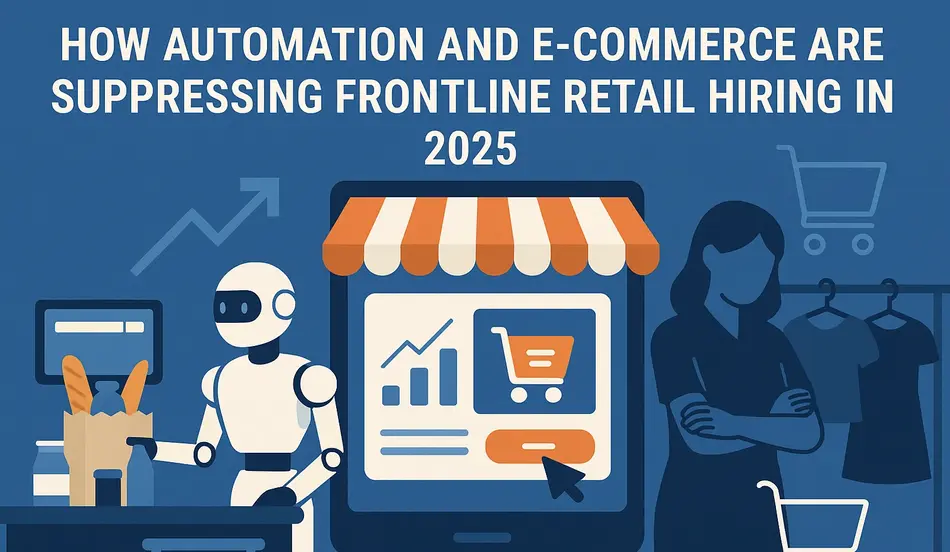Retail hiring in 2025 is under immense pressure, despite continued growth in consumer demand. U.S. retail sales have surged for seven consecutive quarters, yet frontline store employment has remained stubbornly flat. This paradox stems from two major forces: the rapid expansion of e-commerce and the increasing integration of in-store automation. From self-checkout kiosks to AI-powered point-of-sale systems, traditional roles like cashier and sales associate are being phased out.
Even as store foot traffic thrives, hiring stagnates raising red flags about the future of frontline retail employment. This article explores how these technological and strategic shifts are impacting retail hiring, reshaping labor expectations, and forcing the industry to rethink its workforce model.
Table of Contents
E-Commerce’s Meteoric Rise
In Q1 2025, U.S. retail e-commerce sales hit $300.2 billion, up 6.1 percent year-over-year, and accounting for 16.2 percent of all retail transactions. Total retail sales reached $1.858 trillion, a 4.5 percent gain over Q1 2024 . Online platforms—ranging from Amazon and Walmart.com to digitally native brands—now routinely capture one in six dollars spent by American consumers. This growth has fueled record expansion of fulfillment centers and last-mile networks, but has also eroded foot-traffic-driven hiring at brick-and-mortar outlets.
Retail Employment: Flat-Lining Amid Growth
While overall nonfarm payrolls rose by 139,000 jobs in May 2025, employment in the retail-trade sector was effectively unchanged . BLS data confirm that retail trade “showed little change” in May after twelve months of similarly stagnant results. Meanwhile, Challenger, Gray & Christmas reports that announced retail layoffs spiked by 274 percent year-over-year in early 2025, even as consumer demand held strong . In essence, more sales are flowing through digital channels and automated systems, but frontline store headcounts have not increased to match—dampening one of retail’s traditional job-creation engines.
🛍️ Explore Top Retail Jobs on WhatJobs
Worried about how automation is impacting retail hiring?
Discover resilient opportunities in retail operations, supply chain, and customer experience — roles evolving with the future of shopping.
WhatJobs connects you with adaptive retail careers that embrace technology while keeping people at the heart of the customer journey.
👉 Browse top retail jobs now — and stay ahead in a shifting industry.
Self-Checkout and AI-Driven POS
A primary driver of reduced in-store labor needs is the proliferation of self-checkout kiosks and AI-enhanced point-of-sale (POS) systems. Major grocers and mass-market chains—Walmart, Kroger, Target—now deploy hundreds of automated lanes, allowing customers to scan, bag, and pay without a cashier . These systems handle returns, promotions, and loyalty-point redemptions via computer vision and natural-language interfaces. Industry research suggests self-checkout adoption alone may reduce cashier roles by 20–30 percent over the next five years, as routine scanning and payment tasks migrate to machines.
Robotics in Distribution and In-Store Fulfillment
Beyond the storefront, retailers are automating back-of-house and shelf-restocking functions. Amazon, for example, has locked down hiring for its retail division—even as it adds fulfillment-center robots—to keep personnel costs flat. Robotics & Automation News reports that Amazon now operates over 750,000 warehouse robots globally, handling tasks from shelving transport to sorting. While these robots create technical-maintenance and supervisory roles, they displace thousands of pickers and sorters—roles traditionally viewed as entry-level opportunities. Smaller retailers, meanwhile, deploy robotic shelf-scanners and RFID-guided carts to monitor inventory without manual counts.
Omnichannel Fulfillment Reduces Store-Level Hiring
The rise of Buy-Online-Pick-Up-In-Store (BOPIS), curbside pickup, and micro-fulfillment kiosks has further shifted store labor from sales to order-assembly functions. The National Retail Federation notes that omnichannel models now account for over 25 percent of top-tier retailers’ transactions, with many employing separate “click-and-collect” teams or third-party partners . These specialized pickup lanes require fewer, more technical staff—often at centralized hubs—rather than the broad array of floor associates and cashiers needed for traditional over-the-counter sales.
Wage Inflation vs. Applicant Shortages
To compete for a shrinking pool of frontline candidates, many retailers have boosted starting wages into the $16–$18 per hour range—up 8 percent year-over-year. Yet higher pay has not translated into higher application rates: job postings for retail associates increased 15 percent, while unfilled openings grew 12 percent. In high-cost metros, “location premiums” of $2–$3 per hour further strain margins. Surveys reveal that pay alone cannot overcome factors such as unpredictable scheduling, high turnover, and the physical demands of understaffed stores.
Frontline Worker Burnout and Turnover
Recent Logile research shows that 51 percent of frontline associates report chronic understaffing during peak hours, and 82 percent feel overwhelmed by unpredictable schedules. In the same survey, 77 percent said lost sales due to labor shortages directly affected store performance. Burnout drives many to seek roles in logistics, customer-service call centers, or remote gigs—positions offering steadier hours and less face-to-face pressure. As a result, retail turnover remains above 60 percent annually, doubling the corporate average.
Redeployment and Upskilling Strategies
To retain talent and maximize existing staff, retailers are redeploying frontline employees into hybrid roles:
- Digital-Skills Training: Cashiers cross-trained on inventory-management apps, mobile POS, and basic data analytics.
- Customer-Experience Specialists: Upskilling sales associates into advisory roles—style consultants or tech experts—where human interaction adds greater value.
- Flexible Scheduling Platforms: Mobile apps that let employees swap or select shifts, reducing no-show rates by 12 percent.
- Micro-Fulfillment Units: In-store automated lockers handle order packing, requiring fewer full-time staff on sales floors.
These programs often partner with technology providers (e.g., Salesforce, Oracle Retail) to deliver micro-learning and in-flow training modules tailored to specific store technologies.
Policy, Immigration, and Labor Market Dynamics
Several broader labor-market factors compound retailers’ hiring challenges:
- Immigration Policy Uncertainty: With one in five warehousing and store workers foreign-born, stricter enforcement and visa backlogs shrink the candidate pool .
- Circuit Breaker Unemployment Benefits: Generous UI expansions during the pandemic reduced the urgency for low-wage, part-time roles.
- Healthcare & Scheduling Constraints: Retail’s limited benefits and unpredictable hours compare poorly to gig platforms offering “choose-your-schedule” models.
Absent policy interventions—such as work-visa reform for service roles or targeted tax credits for frontline hiring—retailers must navigate an increasingly constrained labor landscape.
Future Skills for Retail Frontlines
As automation handles routine tasks, frontline workers must master:
- Digital Literacy: Operation of self-checkout troubleshooting, mobile inventory scanners, and AI-driven CRM tools.
- Emotional Intelligence: Upselling, complaint resolution, and delivering personalized experiences that algorithms cannot.
- Data-Driven Decision-Making: Interpreting store-level sales dashboards to adjust product displays or promotions in real time.
- Technical Maintenance Basics: Conducting first-line checks on kiosks, scanners, and robotic assistants, flagging issues for repair teams.
Retailers investing in these competencies report 15 percent higher customer-satisfaction scores and 10 percent lower churn among frontline staff.
Toward a Human-Machine Collaboration
The flattening of traditional frontline roles does not signal retail’s demise, but rather its transformation. The most successful retailers in 2025 will integrate automation to handle repetitive tasks, while redeploying human talent into customer-centric, technologically savvy positions. Building a resilient, adaptive workforce requires:
- Holistic Total-Rewards: Competitive wages, schedule flexibility, and clear career pathways.
- Seamless Tech Integration: User-friendly AI/robot interfaces that empower, not replace, employees.
- Data-Backed Workforce Planning: Predictive scheduling and real-time demand signals to align staff levels with traffic patterns.
- Public-Private Partnerships: Engaging community colleges and workforce boards to develop targeted upskilling pipelines.
Only by valuing frontline associates as strategic partners—equipping them with the right tools, training, and support—can retailers sustain growth, elevate the customer experience, and create meaningful employment in an era defined by digital commerce.
For ongoing coverage of retail labor trends, consumer-tech integration, and workforce strategies, visit WhatJobs News.
FAQs
Q: Why isn’t stronger consumer spending driving more store hires?
A: Spending is moving online—e-commerce channels are capturing an increasing share of sales, and automation substitutes for many traditional store roles, leaving overall retail-trade headcounts flat despite revenue gains.
Q: Are these trends permanent?
A: While some level of in-store staffing is essential for experience and customer care, expect ongoing reductions in cashier and basic sales roles as technology continues to evolve and omnichannel models mature.
Q: What skills will frontline retail workers need going forward?
A: Digital-literacy (managing automated kiosks and mobile POS), basic data-entry proficiency, customer-experience expertise, and flexibility to operate across fulfillment and service channels.
Q: How can retailers balance automation with employment?
A: By integrating human-machine collaboration—using automation to handle repetitive tasks while redeploying staff into higher-value advisory, training, and supervisory roles that machines cannot replicate.




